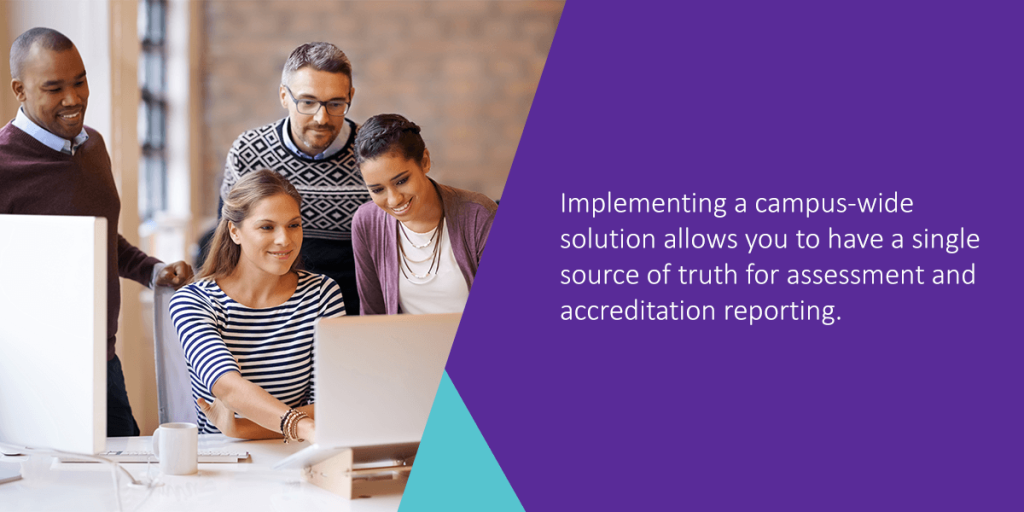
For many institutions, coping with COVID-related obstacles created opportunities to make positive changes. By adopting new solutions or taking advantage of underutilized technologies, colleges and universities began future-proofing their learning and administrative processes to avoid possible disruption down the road.
Though the onset of COVID-19 is in the rearview mirror, it is still critical to monitor your software to continue adapting and evolving key processes on your campus. These guidelines will help you know when it’s time for a tech upgrade.
How to know when it’s time for new tech
Here are a few ways to know whether it’s the right time for new technology:
1. Your process works — but there’s room for improvement
Faculty and staff have a lot to balance, and administrative tasks often fall to the bottom of the to-do list. Assessment, faculty activity reporting, and even course evaluation administration can quickly become time-consuming projects when processes and technology aren’t in alignment.
Is your team struggling to use systems that don’t fully support their day-to-day tasks? Or do they need to relearn how to use complicated tools every time annual reporting rolls around? If so, it’s time to reconsider the tools you’re using.
Software works best when it is chosen to support an effective existing process. Listen closely to the feedback you’re getting about your current systems and consider finding a new solution that more closely matches how your team operates.
2. You’re missing a key feature
Are you managing most of your work in a single software solution but still handling a few critical components outside the system? If yes, you need the right tool for the job. Functional gaps lead to creative workarounds, which are challenging to manage and keep track of.
Consider the impact of using a software solution for accreditation reporting that includes a pre-built template matching your specific accreditor’s requirements. How much time could you save on entry and formatting? What could you accomplish using that time for data analysis instead?
3. You can’t see the full picture
The term “data silos” often comes up when institutions seek new software. A silo is created when data gathered by one group isn’t fully accessible by other groups in the same organization.
Your institution likely has a handful of software tools being used campus-wide and even more applications used independently by individual schools, programs, or departments. This leads to multiple teams entering the same information in their systems, creating inconsistent and inaccurate data sets — and wasting a ton of time!
Implementing a campus-wide solution prevents situations where you manually pull together reports from multiple applications or spend considerable time reentering data that exists in another system, and instead allows you to have a single source of truth for assessment and accreditation reporting.

4. You can’t keep up with change
Over time, teams tend to eliminate extra steps in their processes to focus on the most critical elements. It can be challenging for legacy systems to keep up, mainly when they were chosen to support a process put in place years ago.
Consider the transition to remote work. In-person site visits for accreditation were next to impossible at the height of the pandemic. Teams were forced to adapt their reporting and document submission methods, as they could no longer review binders of data sitting side-by-side at a conference room table. Schools that were already using a digital assessment and accreditation solution were ahead of the game because their reports could be accessed by reviewers online from any location.
Higher education institutions that take advantage of remote and hybrid systems may also maximize interactions through simplified communication channels and extracurricular engagements, which are attractive and more comfortable for some people.
5. You can’t utilize data effectively
Higher education institutions have access to tremendous amounts of data acquired through new student enrollment, financial aid models, staff evaluation, student assessments and many more. However, making sense of all that information is a different ball game.
Installing improved data management solutions can increase revenue, reduce cost, and improve operational quality. For example, evaluating financial aid data helps you identify students’ needs and ability to pay. Data also helps identify trends and compile a compelling academic program portfolio that appeals to students.
Tips for implementing new higher education technology
Here are a few strategies to help you implement effective digital solutions:
1. Assess your needs
Digital transformation is only functional when it addresses problems. Begin the process by assessing operations at all levels to know where there are challenges. This guides you in choosing the best solutions. For example, if you realize that processes are being duplicated, the reason might be that multiple independent software solutions are performing the same or similar tasks. In that case, the optimal step would be to merge those activities by installing a single, well-integrated program.
2. Evaluate and utilize your IT talent
Ensure your IT leader is a full strategic partner and include the chief information officers (CIOs) in dialogues to guide your digital transformation strategies in administrative and academic operations. This proactive approach allows the CIOs to learn about the institution’s mission, culture, and procedures to provide best-fit solutions. Also, where necessary, acquire IT talents equipped with skills, such as data analysts, to execute the desired goals.
3. Update privacy and cybersecurity awareness
Digital tools are necessary if you want to grow and stay competitive. However, one of its primary challenges is cyber attacks. Since higher educational institutions have access to high volumes of data, it helps to include an effective cybersecurity strategy in your digital landscape.
It is vital to update your security systems regularly and educate participants. Set password restrictions and limit access to sensitive information to ensure maximum security. It also helps to occasionally update your security protocols and guidelines to accommodate current breaching techniques.
4. Shift from data insight to data action
Access to data is one of the primary advantages of going digital. The essence of collecting data is to help you make informed decisions and implement effective strategies. Convert data analytics efforts into institutional action plans to lay the foundation for enhancing operational efficiency. For example, you can leverage data to identify and eliminate redundant tasks or use advertisement data to increase interest.
5. Partner with an expert digital solutions provider
Your chosen service provider should understand your needs and offer the best solutions to help you achieve those goals. Whether your needs involve data collection and privacy, information sharing and accessibility, test score reporting, faculty evaluations, or processes for streamlining candidate portfolio creation and submission, the digital solutions should be personalized according to the particular circumstances surrounding your institution. That’s how you increase your return on investment.

Take the next step
Following the guidelines discussed in this article will help you know when it’s time for a new higher education technology and develop practical digital transformation strategies. Download our latest free eBook now to learn how to be a tech champion and drive the adoption of new software, or request a demo!















































































































































































































































































































































































































